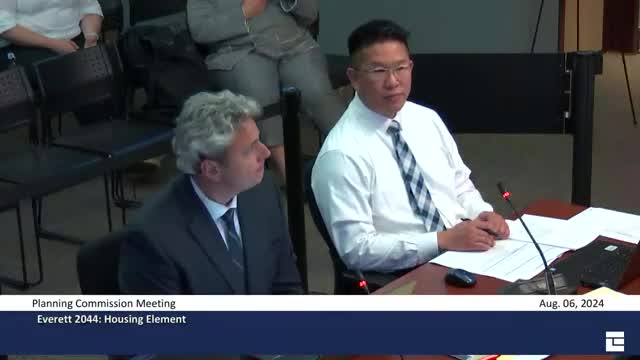Debate ignites over indoor common areas in housing plans
August 06, 2024 | Everett, Snohomish County, Washington
This article was created by AI summarizing key points discussed. AI makes mistakes, so for full details and context, please refer to the video of the full meeting. Please report any errors so we can fix them. Report an error »

During a recent government meeting, commissioners engaged in a robust discussion regarding the inclusion of indoor common areas in new residential developments. The conversation was sparked by a query about whether indoor spaces should be considered as part of the open space requirements typically mandated for new buildings.
Currently, the city requires developers to provide a minimum of 75 square feet of common and open space per unit for studio and one-bedroom apartments, and 100 square feet for two-bedroom units. For developments with over 50 units, at least 50% of this space must be outdoors. However, some commissioners argued for the flexibility to allow indoor spaces to fulfill these requirements, citing the potential for innovative designs and the practical benefits of indoor areas, especially in a region known for its rainy climate.
Commissioner Adkins highlighted the importance of green space for health and wellness, expressing concern that relying solely on indoor common areas could detract from the availability of outdoor green spaces. The discussion also touched on the accessibility of parks and whether developments located near parks could reduce the need for on-site green space.
The commissioners acknowledged the challenges developers face in providing adequate outdoor space, particularly in densely populated areas. They debated the merits of allowing indoor spaces while ensuring that residents still have access to outdoor environments. Some suggested that the city should take a more active role in providing public parks and green spaces to complement private developments.
As the meeting progressed, the commissioners considered the implications of their decisions on housing affordability and community expectations. They recognized the need for a balanced approach that accommodates both indoor and outdoor spaces, particularly in different neighborhoods, and agreed that the market should play a role in determining the types of amenities that residents value.
The conversation underscored the complexities of urban planning and the ongoing challenge of meeting community needs while fostering development. The commissioners left the meeting with a commitment to further explore how to integrate indoor common areas into the city’s open space requirements without compromising the health and wellness of residents.
Currently, the city requires developers to provide a minimum of 75 square feet of common and open space per unit for studio and one-bedroom apartments, and 100 square feet for two-bedroom units. For developments with over 50 units, at least 50% of this space must be outdoors. However, some commissioners argued for the flexibility to allow indoor spaces to fulfill these requirements, citing the potential for innovative designs and the practical benefits of indoor areas, especially in a region known for its rainy climate.
Commissioner Adkins highlighted the importance of green space for health and wellness, expressing concern that relying solely on indoor common areas could detract from the availability of outdoor green spaces. The discussion also touched on the accessibility of parks and whether developments located near parks could reduce the need for on-site green space.
The commissioners acknowledged the challenges developers face in providing adequate outdoor space, particularly in densely populated areas. They debated the merits of allowing indoor spaces while ensuring that residents still have access to outdoor environments. Some suggested that the city should take a more active role in providing public parks and green spaces to complement private developments.
As the meeting progressed, the commissioners considered the implications of their decisions on housing affordability and community expectations. They recognized the need for a balanced approach that accommodates both indoor and outdoor spaces, particularly in different neighborhoods, and agreed that the market should play a role in determining the types of amenities that residents value.
The conversation underscored the complexities of urban planning and the ongoing challenge of meeting community needs while fostering development. The commissioners left the meeting with a commitment to further explore how to integrate indoor common areas into the city’s open space requirements without compromising the health and wellness of residents.
View full meeting
This article is based on a recent meeting—watch the full video and explore the complete transcript for deeper insights into the discussion.
View full meeting
